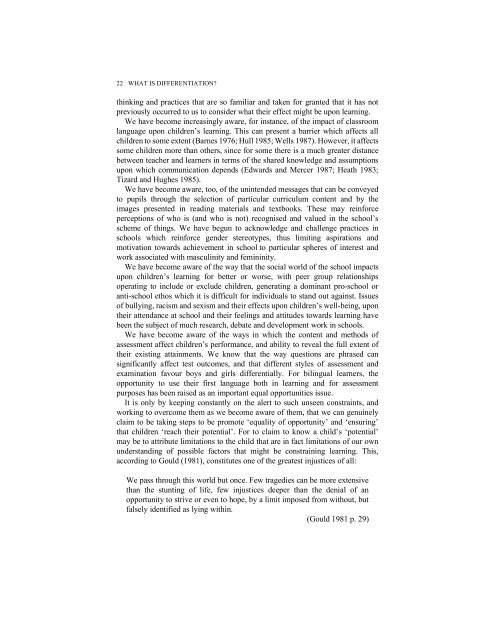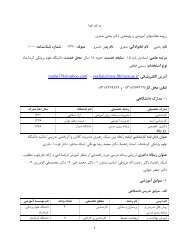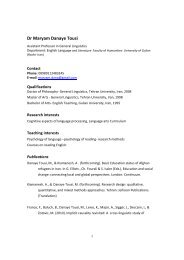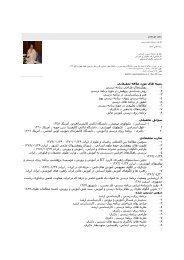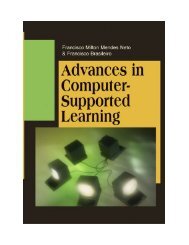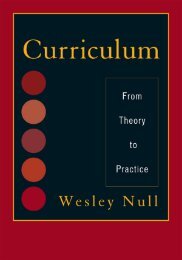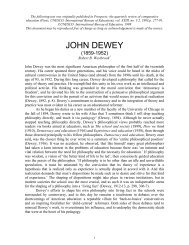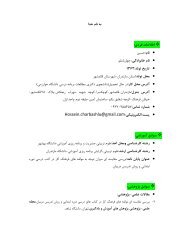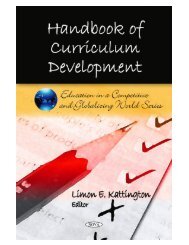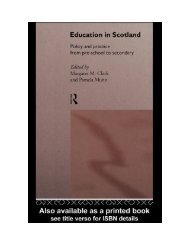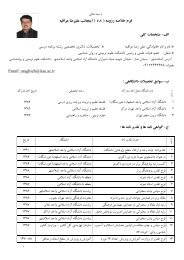Edited by
Edited by
Edited by
You also want an ePaper? Increase the reach of your titles
YUMPU automatically turns print PDFs into web optimized ePapers that Google loves.
22 WHAT IS DIFFERENTIATION?thinking and practices that are so familiar and taken for granted that it has notpreviously occurred to us to consider what their effect might be upon learning.We have become increasingly aware, for instance, of the impact of classroomlanguage upon childrens learning. This can present a barrier which affects allchildren to some extent (Barnes 1976; Hull 1985; Wells 1987). However, it affectssome children more than others, since for some there is a much greater distancebetween teacher and learners in terms of the shared knowledge and assumptionsupon which communication depends (Edwards and Mercer 1987; Heath 1983;Tizard and Hughes 1985).We have become aware, too, of the unintended messages that can be conveyedto pupils through the selection of particular curriculum content and <strong>by</strong> theimages presented in reading materials and textbooks. These may reinforceperceptions of who is (and who is not) recognised and valued in the schoolsscheme of things. We have begun to acknowledge and challenge practices inschools which reinforce gender stereotypes, thus limiting aspirations andmotivation towards achievement in school to particular spheres of interest andwork associated with masculinity and femininity.We have become aware of the way that the social world of the school impactsupon childrens learning for better or worse, with peer group relationshipsoperating to include or exclude children, generating a dominant pro-school oranti-school ethos which it is difficult for individuals to stand out against. Issuesof bullying, racism and sexism and their effects upon childrens well-being, upontheir attendance at school and their feelings and attitudes towards learning havebeen the subject of much research, debate and development work in schools.We have become aware of the ways in which the content and methods ofassessment affect childrens performance, and ability to reveal the full extent oftheir existing attainments. We know that the way questions are phrased cansignificantly affect test outcomes, and that different styles of assessment andexamination favour boys and girls differentially. For bilingual learners, theopportunity to use their first language both in learning and for assessmentpurposes has been raised as an important equal opportunities issue.It is only <strong>by</strong> keeping constantly on the alert to such unseen constraints, andworking to overcome them as we become aware of them, that we can genuinelyclaim to be taking steps to be promote equality of opportunity and ensuringthat children reach their potential. For to claim to know a childs potentialmay be to attribute limitations to the child that are in fact limitations of our ownunderstanding of possible factors that might be constraining learning. This,according to Gould (1981), constitutes one of the greatest injustices of all:We pass through this world but once. Few tragedies can be more extensivethan the stunting of life, few injustices deeper than the denial of anopportunity to strive or even to hope, <strong>by</strong> a limit imposed from without, butfalsely identified as lying within.(Gould 1981 p. 29)


